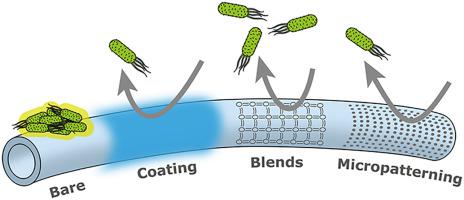Advances in Colloid and Interface Science ( IF 15.9 ) Pub Date : 2020-08-06 , DOI: 10.1016/j.cis.2020.102230 Célia M C Faustino 1 , Sara M C Lemos 1 , Nuno Monge 2 , Isabel A C Ribeiro 1

|
The use of invasive medical devices is becoming more common nowadays, with catheters representing one of the most used medical devices. However, there is a risk of infection associated with the use of these devices, since they are made of materials that are prone to bacterial adhesion with biofilm formation, often requiring catheter removal as the only therapeutic option. Catheter-related urinary tract infections (CAUTIs) and central line-associated bloodstream infections (CLABSIs) are among the most common causes of healthcare-associated infections (HAIs) worldwide while endotracheal intubation is responsible for ventilator-associated pneumonia (VAP). Therefore, to avoid the use of biocides due to the potential risk of bacterial resistance development, antifouling strategies aiming at the prevention of bacterial adherence and colonization of catheter surfaces represent important alternative measures. This review is focused on the main strategies that are able to modify the physical or chemical properties of biomaterials, leading to the creation of antiadhesive surfaces. The most promising approaches include coating the surfaces with hydrophilic polymers, such as poly(ethylene glycol) (PEG), poly(acrylamide) and poly(acrylates), betaine-based zwitterionic polymers and amphiphilic polymers or the use of bulk-modified poly(urethanes). Natural polysaccharides and its modifications with heparin, have also been used to improve hemocompatibility. Recently developed bioinspired techniques yielding very promising results in the prevention of bacterial adhesion and colonization of surfaces include slippery liquid-infused porous surfaces (SLIPS) based on the superhydrophilic rim of the pitcher plant and the Sharklet topography inspired by the shark skin, which are potential candidates as surface-modifying approaches for biomedical devices. Concerning the potential application of most of these strategies in catheters, more in vivo studies and clinical trials are needed to assure their efficacy and safety for possible future use.
中文翻译:

防污策略可防止导管相关感染。
如今,侵入性医疗设备的使用变得越来越普遍,导管代表了最常用的医疗设备之一。但是,使用这些装置存在感染的风险,因为它们是由易于与生物膜形成细菌粘附的材料制成的,因此通常需要取下导管作为唯一的治疗选择。导管相关的尿路感染(CAUTIs)和中线相关的血流感染(CLABSIs)是全世界医疗保健相关感染(HAIs)的最常见原因,而气管插管引起呼吸机相关性肺炎(VAP)。因此,为了避免由于产生细菌耐药性的潜在风险而使用杀菌剂,旨在防止细菌粘附和导管表面定植的防污策略是重要的替代措施。这项审查的重点是能够改变生物材料的物理或化学特性,从而导致抗粘附表面产生的主要策略。最有前途的方法包括在表面涂上亲水性聚合物,例如聚乙二醇(PEG),聚丙烯酰胺和聚丙烯酸酯,甜菜碱型两性离子聚合物和两亲性聚合物,或使用本体改性的聚(氨基甲酸酯)。天然多糖及其对肝素的修饰也已用于改善血液相容性。最近开发的生物启发技术在防止细菌粘附和表面定殖方面取得了非常有希望的结果,包括基于捕虫器的超亲水边缘的光滑液体注入多孔表面(SLIPS)和受鲨鱼皮肤启发的Sharklet地形,这是潜在的候选物作为生物医学设备的表面改性方法。关于大多数这些策略在导管中的潜在应用,更多需要进行体内研究和临床试验以确保其有效性和安全性,以备将来使用。











































 京公网安备 11010802027423号
京公网安备 11010802027423号